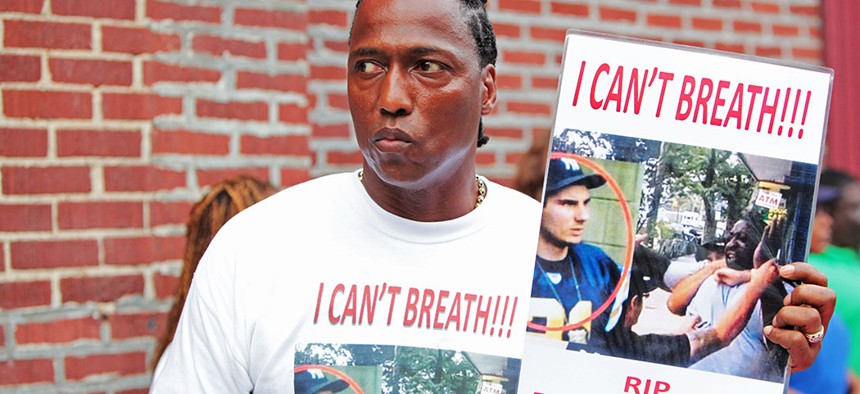New York City
How to hold cops legally accountable for killings
Three straightforward steps can start to change the lack of legal accountability for police officers who kill people, writes Alvin Bragg, a former chief deputy attorney general in New York.

A man attending funeral services for Eric Garner, the Staten Island resident who died while being taken into custody by an NYPD officer in 2014. A Katz/Shutterstock
This week, NYPD Officer Daniel Pantaleo is finally being prosecuted – but not criminally. The New York City Civilian Complaint Review Board can, at most, get him fired for his role in the death of Eric Garner on Staten Island five years ago. A Staten Island grand jury decided in December 2014 not to charge Pantaleo with any crime.
Since the grand jury’s decision, more than 4,000 people have been killed in the United States by police officers. African Americans make up just 13% of the U.S. population, but about 23% of these deaths. The data for young African American boys and men are even more startling. According to one 2015 study, African American males between ages 15 and 34, roughly 2% of the U.S. population, made up more than 15% of all deaths caused by police.
This is why African American parents like me have “the talk” with our children about police stops: keep your hands in sight; no quick movements; yes, I want you to know and invoke your constitutional rights, but first and foremost, I want you to come home alive.
For families who lose a son or a daughter, accountability for police conduct remains elusive. Criminal charges are rarely brought against the police officers involved, and generally, families receive no information about why criminal charges were not brought. Of the thousands of police shootings between 2005 and 2015, only 54 officers were charged. Very few cases end with a conviction.
Three straightforward steps – while not a panacea – can start to change this painful situation. First, change who prosecutes these cases. Second, change the applicable laws. Third, require prosecutors to disclose their investigative findings in situations where no criminal charges are brought.
First, these cases, like most potential crimes, are investigated by local district attorneys. The intertwined relationship between a district attorney and the local police department – who work together day in and day out – can affect the course of justice when a police officer is under investigation. For this reason, in cases involving police actions leading to the death of an unarmed civilian, states should require the appointment of special prosecutors who do not regularly work with local police, or, as happened in New York state, the appointment of a standing special prosecutor with this responsibility.
I was New York’s first special prosecutor, working in the state attorney general’s office, under an order issued by Gov. Andrew Cuomo. My experience confirmed the merit of this approach. About a year after New York made this change, Rensselaer County District Attorney Joel Abelove quickly “cleared” Sgt. Randall French, who shot and killed a civilian, Edson Thevenin. Our subsequent investigation resulted in criminal charges against the district attorney, alleging that he withheld key evidence from the grand jury and improperly shielded the officer from prosecution by granting him immunity. There is still no resolution of this case, as the charges were initially dismissed and are currently on appeal, but the spotlight on the district attorney’s actions helped lead to his electoral defeat.
Second, the laws governing these cases, including in New York, need to change. These cases often turn on a self-defense argument: If an officer reasonably believes deadly force is necessary to save his or her own life, then the officer may lawfully use deadly force. Obviously, police officers have dangerous, life-threatening jobs and perform a very valuable public service. But it cannot be that no matter the circumstances, every officer is always reasonable in believing that the use of deadly force was necessary. Yet juries almost invariably conclude that this was the case. New laws should make it clear that “necessary” means that the officer exhausted all other options and had no reasonable alternative to the use of deadly force. In other words, “necessary” means absolutely necessary. This subtle change underscores the gravity of an officer’s decision to use deadly force. It would also likely affect prosecutors’ decisions to charge officers and, ultimately, decisions by juries to convict.
Third, even with new legal standards, there will inevitably be cases where no charges are warranted. Currently, in many such cases, prosecutors attribute the decision not to charge an officer to the grand jury that heard the case, even when that may have been where the prosecutor led the grand jury. The proceedings of grand juries are generally legally sealed, providing no information for anyone seeking transparency. That is why prosecutors should be required to issue public reports of their investigative findings when no charges are brought. Crime scene photos, firearm tests, autopsy reports, body camera videos and other key evidence are all within the hands of the government and can be the subject of a public report without violating the secrecy rules of grand juries. In addition to stating investigative findings, these reports should point out ways to improve law enforcement practices that might avoid future tragedies.
These three steps would lead to fairer, more transparent investigations and, where appropriate, a greater likelihood of prosecutions and convictions of officers that use deadly force. They would also help restore at least some semblance of faith in the system, which for too many communities, has all but disappeared.
NEXT STORY: New York will get Trump’s tax returns

